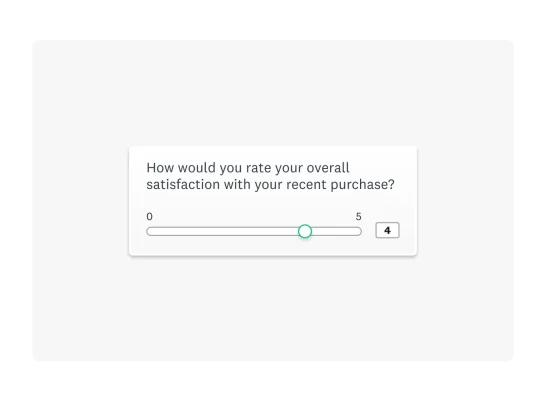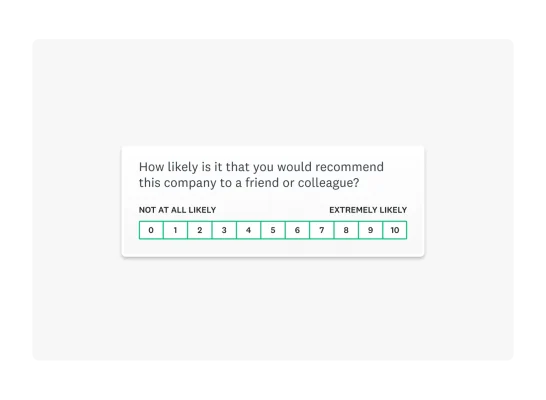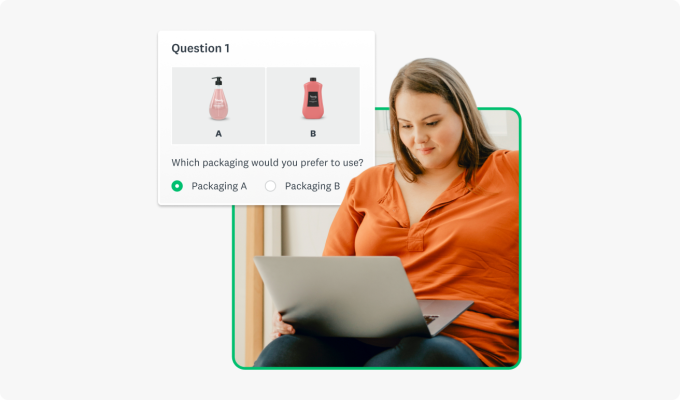Marketing surveys: Types, 70+ examples, and best practices
Discover 70+ essential marketing survey questions and best practices to gather actionable insights.

As a marketer, simply guessing what motivates and appeals to your customers and target audience won’t cut it. Whether launching a new business or managing an established brand, it’s critical to be guided by insights so you don’t waste time, resources, or your audience’s attention.
Let’s go over the different types of marketing surveys, with example questions, and how to use these surveys to strengthen marketing campaigns.
What are marketing surveys?
Marketing surveys are a powerful research method used to gather data and actionable insights about customers and prospects so businesses can understand and meet their needs.
Research experts commonly use marketing surveys for market research, but many different types of surveys can gather different kinds of quantitative and qualitative insights, such as:
- Brand awareness
- Customer experience
- Product experience
- Consumer behavior
- General market research
No matter the type of marketing survey, the results help businesses make data-driven decisions by illuminating what customers or potential customers want, need, and expect. Marketers can use that information to shape their strategies and better engage their audience.
Related reading: Why are surveys important in research?
Why use marketing surveys?
Marketing surveys are essential for conducting market research and keeping up with customers. They can gather customer feedback and market research data to inform product development, marketing strategies, ad campaign development, customer touchpoint improvements, competitive analysis, and more.
When it comes to the process of gathering feedback, marketing surveys tend to be:
- More cost-effective than focus groups
- Faster and more agile than other research methods since you can launch quickly using market research survey templates or available AI-powered survey creation
- Convenient for data collection since you can send surveys via email, SMS, website, point of sale (POS) pop-ups, or offline on mobile devices at events
Types of marketing surveys and 70+ questions

Companies can use marketing surveys in any industry to gain critical business insights and market research data. While the focus of market research surveys often overlap, here are the most popular types, along with example survey questions.
Market research surveys
It can be helpful to think of market research surveys as an umbrella category since marketing surveys like Net Promoter Score (NPS®), price optimization, usage and attitudes, competitor analysis, and more are all considered market research surveys.
Marketers conducting general market research tend to focus on getting survey data to boost their brand, build better products, understand consumers’ habits, and improve experiences.
Related guide: The 6-step market research process
Example questions from market research survey templates:
- Are you the primary decision-maker in your household regarding purchasing this product category?
- Which factors are important to you when you decide which brands to purchase?
- How do you typically find out about brands in this product category?
- Which of the following are reasons that you might purchase this product?
Success story: How Kajabi builds brand strength with competitive insights
Customer satisfaction surveys
The whole point of a customer satisfaction survey is to understand whether your customers are happy, unhappy, or somewhere in between—and a good survey will collect that feedback and build trust between you and your customers.
Example questions:
- Overall, how satisfied or dissatisfied are you with our company?
- Overall, how satisfied or dissatisfied are you with the customer support you received?
- How would you rate the quality of the product?
- Which of the following words would you use to describe our products? Select all that apply.
- How well do our products meet your needs?
- How long have you been a customer of our company?

Net Promoter Score (NPS) surveys
An NPS survey is a simple way to measure customer satisfaction and loyalty so you can inspire more brand advocates. Any NPS survey template focuses on a central, closed-ended question; marketers often include a follow-up open-ended question to collect more context and information from respondents.

Example questions:
- On a scale of one to ten, how likely is it that you would recommend this company to a friend or colleague?
- What is the main reason you selected that rating? [Open-ended question]
- What was missing in your experience with us? [Open-ended question]
- What did you like best about our products? [Open-ended question]
Success story: How Point of Reference gets more out of NPS surveys
Product feedback surveys
Product feedback surveys collect the information you need to create products that go above and beyond your customers’ expectations. This will boost customer satisfaction and help your teams innovate with intention.
Product surveys are useful throughout the product lifecycle, from product development to maturity, and collect an array of insights about current products, product concepts, and even product packaging.
Example questions:
- What are the things you like most about this product? [Open-ended question]
- What are the things you like least about this product? [Open-ended question]
- How would you rate the quality of this product?
- How innovative is this product?
- When you think about the product, do you think of it as something you need or don’t need?
- Click on the area you like best about this product. [Click map question]

Brand awareness surveys
A brand awareness survey uncovers an important aspect of your overall brand health: whether your target market is even aware of your brand, products, or services. These market research insights help focus your marketing efforts on your market position and how you stack up against competitors.
Example questions:
- Which of the following brands have you heard of? Select all that apply.
- How familiar are you with our brand?
- When did you first hear about our brand?
- In the past 3 months, where have you seen or heard about our brand?
- How would you describe your overall opinion of our brand?
- How has your perception of our brand changed in the past 3 months?
Success story: How Tweezerman grows its global brand
Customer persona surveys
Are you clear on your ideal customer profile? What about your buyer personas? Customer persona surveys give you a deeper understanding of who you’re marketing to, including demographics, consumer attitudes, and purchase drivers. You can use these market research insights to refine your messaging, targeting strategies, and more.
Example survey questions:
- How often do you purchase products in this product category?
- Which of these brands do you typically buy?
- What problems does our product/service help you solve?
- What is your age?
- What is your gender identity?
- Which race or ethnicity best describes you? Select all that apply.
Pricing surveys
Whether you’re launching a new product or reconsidering the price of existing products or services, you want to make sure you don’t leave money on the table—or turn customers off with too high of a price tag. Pricing research surveys, or a price optimization solution, are a kind of market research that allows you to find out exactly what people are willing to pay so you can price your products with confidence.
Example survey questions:
- What price would you be willing to pay for this product?
- At what price point would you think the product is too cheap that you would question the quality and not consider it?
- At what price point is the product a bargain or a great buy for the money?
- At what price point would you think the product is too expensive and wouldn’t consider it?
- How would you rate this product’s value for money?
- If this product were available today, how likely would you buy it?
Customer journey surveys
The best way to understand and improve your customer journey is to use surveys to check in with your customers throughout the customer lifecycle. This feedback can help you see if new customers are having a better experience than long-time customers or if certain touch points are causing friction.
Example survey questions:
- When did you first purchase a product/service from our brand?
- Overall, how satisfied were you with the checkout process?
- How easy was it to find what you were looking for on our website?
- Overall, how satisfied were you with the delivery experience?
- Do you follow our brand on social media platforms?
- How do you typically find out about brands in this product category?
- How often do you interact with our brand on social media?
Competitive analysis surveys
It’s one thing to know who your competitors are in an abstract sense—it’s another to know how you compare in the eyes of your target audience. Competitor research surveys are a great way to gauge your brand reach, spot market gaps, and make sure your competitive differentiation is based on market research.
Example survey questions:
- When you think of this product category, what brands come to mind? [Open-ended question]
- Which of the following brands have you heard of?
- Have you ever purchased something from our company?
- Have you heard of [competitor company]?
- Have you ever purchased something from [competitor company]?
- Overall, how satisfied were you with your purchase from [competitor company]?
Event feedback surveys
There’s a lot that goes into brainstorming, organizing, and delivering stellar events. Event feedback survey templates are popular with marketers precisely because they simplify all that work.
Pre-event surveys will show what will make people attend and what will generate positive buzz. Post-event surveys will help you understand what went well and what can be improved. You can even use surveys and polls during the event to capture leads and boost engagement in real time.
Example survey questions:
- What topics would you most like to learn about or discuss at this event?
- How likely is it that you would recommend this event to a friend or colleague?
- How satisfied were you with the registration process for this event?
- What did you like about this event? [Open-ended question]
- What did you dislike about this event? [Open-ended question]
- How organized was the event?
- Was the event too long, too short, or about right?
Customer service surveys
A customer service survey allows you to quickly follow up with customers after they’ve interacted with your customer service team and get insights on whether that support hit the mark and positively impacted the customer experience (CX).
This is important because a customer’s call for help (sometimes literally, in the form of a phone call with your customer service team) can make or break their relationship with your brand, affecting brand reputation and long-term customer loyalty.
Example survey questions:
- Was your issue completely resolved?
- How much time did it take us to address your questions and concerns?
- Overall, how satisfied were you with your customer support experience?
- Is there anything that would improve our customer support? [open-ended question]
- How helpful was the representative you spoke with?
- Are you aware of our AI-assisted customer service chat bot?
Website feedback surveys
Do your customers think your website is modern, visually appealing, or clunky and challenging to navigate? Does your site do everything it’s supposed to, from speeding customers through the checkout process to creating an enjoyable browsing experience? A website feedback survey and user experience metrics will help you uncover what’s great about your website and online presence and what’s not.
Example survey questions:
- Click on the image to indicate what section of the page you like the most. [Click map question]
- Overall, how well does our website meet your needs?
- How easy was it to find what you were looking for on our website?
- Did it take you more or less time than you expected to find what you were looking for on our website?
- Overall, how satisfied were you with the online checkout process?
- How visually appealing is our website?
- How could we improve our website? [Open-ended question]
The major benefits of marketing surveys
Here’s why you should add marketing surveys to key stages in the customer journey and your market research process:
Understand customer preferences and behavior
Your audience’s likes, dislikes, and habits can change on a dime—and when you don’t keep up with those changes, it’ll cost your company much more than that.
Using marketing surveys to conduct market research on consumer behavior and preferences means you’ll know how to create stronger emotional connections and actually meet their needs.
Identify market trends
Is your target audience adjusting their spending to support companies that align with their values? Are Millennials and Gen Z consumers doing all their product category research on social platforms? Trends move fast, and brands with rich market research insights can adapt early and gain a competitive advantage.
Improve products and services
Feedback from customers and your target audience can improve your product development, product updates and feature releases, and customer satisfaction. When you build things with careful consideration of what your customers say they want and need, it demonstrates that you’re a company that listens to and values its customers.
Enhance marketing strategies
Your marketing strategies are only as strong as your insights. For instance, you might transform your social media investments after learning which social media influencers hold the most sway with consumers or which social platforms consumers consider the most trustworthy—two insights uncovered by SurveyMonkey research. With data from marketing surveys, you can establish more strategic goals and make the right moves faster.
Measure customer satisfaction and loyalty
Customer satisfaction can impact everything from your brand equity to your revenue, which is why customer satisfaction insights are particularly valuable. They help you identify and address customer pain points, the key drivers of satisfaction, and how to cultivate a loyal customer base. Not to mention, CSAT metrics are vital for benchmarking performance and setting future goals.
Success story: How Ryanair collects CSAT insights at scale
Make data-driven decisions
Imagine you’re planning to launch a new product or service to your existing market. Without market research, you won’t have a clear idea of the optimal price, the best distribution plan, how your audience will receive the product, or even whether the product will actually sell.
Investing time and effort in the market research process means that you can minimize risks and make data-driven decisions that will grow your business.
How to conduct a marketing survey in 6 steps
Okay, so how do you kick off your own marketing survey? We’ve broken down the process into six basic steps:
1. Define your research goals
As we mentioned, there are lots of different types of marketing surveys and reasons to conduct them. You should always start the marketing survey design process by knowing your survey objective: what you aim to learn through your survey(s).
Here are a few examples of research goals:
- To improve retention among Gen Z and Millennial customers, we want to discover their purchase drivers and relationship with our brand.
- To optimize our brand marketing campaign and ROI, we want to conduct ad testing to determine what resonates with our key customer personas.
Keep in mind, specificity is important for your goals. For the best results, you should know who you want to hear from, what you want to ask about, and why.
2. Identify your target audience
Do you want to hear from existing customers or target customers? Are you aiming to look closer at your target market to understand specific demographics or customer segments? To reach your target audience, you need to know your target audience; refer to the work you did on your research goals and let that guide your targeting.
For example, if your goal is to optimize your ad spend on social media platforms, you may target people who follow your brand’s accounts or spend a certain amount of time using social media per week. Or, you may want to segment your target customers based on age to see how different generations view your ads or your social media presence in general.
3. Create a survey timeline
Outlining timeline expectations for your survey will support your survey goals and help you ensure stakeholders are clear on the next steps. At this point in the process, you should determine:
- Will the survey be sent multiple times? Sending surveys regularly is a best practice since you can get repeated value from a single survey. It also means you can benchmark results, track trends in your target market, transition to a longitudinal study, or replicate results to prove a theory.
- When will the survey be sent? This is especially important to determine if certain actions trigger your survey. For instance, you may deploy a customer service survey within 24 hours of a support call.
- When will data analysis be conducted? Make sure there’s agreement on who will be analyzing results and when. Plus, try to factor in how quickly you’ll aim to act on insights once you have them.
4. Design your survey questions
Here’s yet another moment where your research goal can guide the way. That objective will shape what you ask and how you design a marketing survey, including the question types you use.
Here are just a few best practices for writing survey questions:
- Ask a mix of closed-ended and open-ended questions so you can measure variables and capture respondents’ thoughts and feelings in their own words.
- Make sure your questions are neutral so that leading and loaded questions don’t skew the data you receive or negatively impact your response rate.
- Make sure your answer choices are consistently balanced. If you give respondents a scale of choices, that scale should have equal opportunity for positive, negative, or neutral answers. For instance:
- Very helpful
- Helpful
- Neither helpful nor unhelpful
- Unhelpful
- Very unhelpful
Remember, you can always use an expert-written survey template to make sure you’re asking the right questions the right way. (They’re also customizable, so you can include more or different questions.) Or rely on AI to craft survey questions for your specific target market.
5. Send your survey and collect responses
Time to get your survey out the door! One of the many benefits of online surveys is that there are lots of ways to send your survey.
For instance, if your survey is meant for existing customers rather than a market research panel, you can send it via email, SMS, web embedding, or a combination of those options.
6. Analyze the data
Ready to dig into data? Here are some best practices to help you smooth out the market analysis process and get actionable insights:
- Weight your surveys. Weighting a survey allows you to make the sample of respondents appear closer to the broader population of your target market.
- Use filters and combined filters to get the most out of your market research data and create laser-focused reports.
- Use cross tabs to understand different groups of respondents and compare their responses.
“SurveyMonkey provides very useful data organization and visualization that enable us to quickly analyze responses, identify trends, and extract meaningful insights without a lot of extra effort—which is especially good for fast-paced research. Its built-in survey logic features, such as skip logic and branching, help us create more dynamic, sophisticated surveys that improve response quality.”
-Dr. Tara Fannon
Research Director, Aptive
Get the most out of your marketing surveys with SurveyMonkey
Marketing surveys can unearth all kinds of opportunities for your brand and business, from gaps in your customer experience or retail trends to simple ways to reach more target customers.
Find out why marketers rely on SurveyMonkey to collect market research insights and customer feedback that help them do their jobs better. Start with our general market research survey templates or explore connected to your specific use case or industry, and start asking the questions that’ll guide your strategies.
FAQ: Marketing surveys
- What’s the difference between marketing surveys and market research surveys?
- What are good marketing survey questions?
- How do I create a marketing feedback system?
- Should I use qualitative or quantitative questions in marketing surveys?
- How are marketing surveys conducted?
Ready to get started?
NPS®, Net Promoter® & Net Promoter® Score are registered trademarks of Satmetrix Systems, Inc., Bain & Company, and Fred Reichheld.
Discover more resources

Understand your target market to fuel explosive brand growth
Brand marketing managers can use this toolkit to understand your target audience, grow your brand, and prove ROI.

Hornblower enhances global customer experiences
Discover how Hornblower uses SurveyMonkey and powerful AI to make the most of NPS data, collect customer insights, and improve customer experiences.

Marketing trends: 3 strategies to stay relevant and ready for what's next
New SurveyMonkey research reveals critical insights on the state of marketing. Discover marketing trends to fuel your strategies and stay relevant.

8 marketing trends in 2025: consumer perspectives on AI and social media
Get insights on how AI and social media marketing activities impact consumer buying decisions in our new marketing trends report